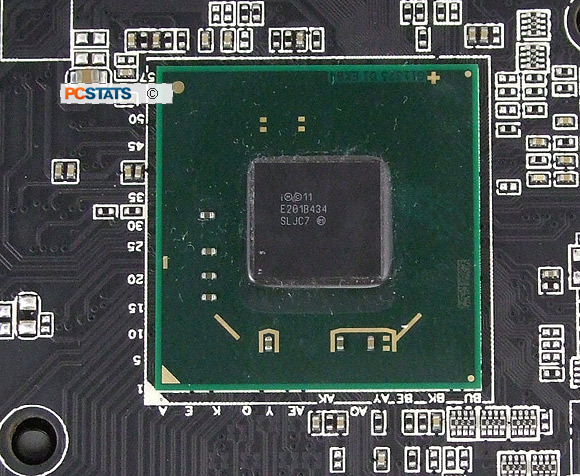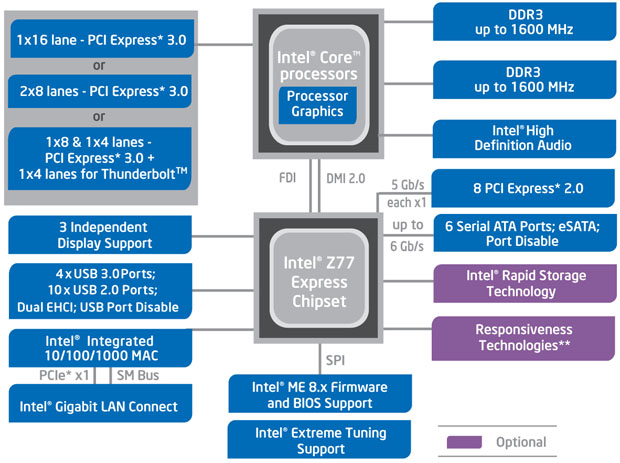
|
There's nothing finer than a new chipset to kick the summer off and this year it's the Intel Z77 Express. In this review PCSTATS will put the performance oriented Gigabyte GA-Z77X-UD3H motherboard, which is built on Intel's shiny new Z77 Express chipset, through its paces with the exceptionally popular 32nm 2nd Gen. Intel Core i3/i5/i7 'Sandy Bridge' processor.
80% Rating: 
|
|
|
|
Home >
Reviews >
Motherboards >
Gigabyte GA-Z77X-UD3H |
|
|
Introducing the Intel Z77 Express Chipset
Intel Z77
Express Chipset
 Intel's Z77 Express chipset has
essentially the same feature set of the Intel Z68, the notable new addition
being native USB 3.0 and a set of software tools Intel calls Platform Responsiveness Technologies - we'll get to
those in a bit. Intel's Z77 Express chipset has
essentially the same feature set of the Intel Z68, the notable new addition
being native USB 3.0 and a set of software tools Intel calls Platform Responsiveness Technologies - we'll get to
those in a bit.
Both the Intel Z77 'Panther Point' and Intel Z68 'Couger
Point' chipsets are built on the 65nm process and support 32nm 2nd Gen. 'Sandy
Bridge' and 22nm 3rd Gen. 'Ivy Bridge' Intel Core i3/i5/7 socket LGA1155
processors. For the first time in a long while, Intel's allowing users to
upgrade without switching CPU sockets!
The Intel
7-series chipset family encompasses a few different models; Z77, H77, Z75, B75
and a few Q models that are beyond the scope of this article. The Intel Z77
serves up onboard video outputs from the integrated graphic core of Sandy Bridge
and Ivy Bridge processors, CPU/Mem/IGP overclocking, Intel Smart Response
Technology, Intel QuickSync media transcoding acceleration and SLI/Crossfire.
Furthermore, Intel Z77 boards support triple monitor displays off the IGP
when an Ivy Bridge CPU is used.
|

The Intel Z77 Express
Chipset
|
Intel 3rd Gen. Core i3/i5/i7 'Ivy Bridge" processors add
DX11 IGP into the mix and PCI Express 3.0 support for discrete videocards. The
new CPUs also bump memory support from DDR3-1333 to DDR3-1600. In the past
integrated graphics and memory were handled by the Northbridge chipset, but now
the exact platform capabilities depend in equal part on the CPU as you can see
by the block diagram below:
|

The
Intel Z77 Express Chipset block diagram
|
As with previous
Intel H67 and Z68 chipsets, the Intel Z77 PCH communicates with the socket
LGA1155 processor over a DMI2.0 link at 20Gb/s and via the Intel Flexible
Display Interface. Sandy Bridge CPUs host eight PCI Express 2.0 lanes running at
5Gb/s. Ivy Bridge CPUs host sixteen PCI Express 3.0 lanes (or 2x8 or 1x8, 1x4
and 1x4 Thunderbolt).
| Intel
Chipset Comparisons |
|
Intel X79 Express
|
Intel Z77 Express |
Intel Z68 Express |
Intel P67 Express
|
Intel H67
Express |
| CPU |
LGA 2011
2nd Gen. Core i7 / Extreme |
LGA 1155
Core i3/i5/i7 3rd/2nd Gen |
LGA 1155
Core i3/i5/i7 2nd Gen. |
LGA 1155
Core i3/i5/i7 2nd Gen. |
LGA 1155
Core i3/i5/i7 2nd Gen. |
| Chipset Code Name |
Patsburg (65nm) |
Panther Point (65nm) |
Couger Point (65nm) |
Couger Point (65nm) |
Couger Point
(65nm) |
| Bus Interface / Speed |
DMI 2.0, 20Gb/s |
DMI 2.0, 20Gb/s &
Intel FDI |
DMI 2.0, 20Gb/s &
Intel FDI |
DMI 2.0, 20Gb/s |
DMI 2.0, 20Gb/s &
Intel FDI |
| Memory Support |
DDR3-1600, quad
channel |
DDR3-1600, dual
channel |
DDR3-1333, dual
channel |
DDR3-1333, dual
channel |
DDR3-1333, dual
channel |
| Maximum Memory
Capacity |
64GB (64-bit) |
32GB (64-bit) |
32GB (64-bit) |
32GB (64-bit) |
32GB (64-bit) |
| Integrated Graphics /
Intel FDI |
- |
Yes |
Yes |
- |
Yes |
| Integrated Graphics
Ports |
- |
HDMI, DVI, DP, VGA
(3-way monitor with IvyBridge CPU) |
HDMI, DVI, DP, VGA
(dual monitor) |
- |
HDMI, DVI, DP, VGA
(dual monitor) |
PCI Express 2.0 Lanes
(chipset) |
8 |
8 |
8 |
8 |
8 |
| Intel Rapid Storage
Technology (RST) |
RST enterprise 3 |
iRST 11 |
RST 10 |
RST 10 |
RST 10 |
| Intel Smart Response
Technology (SRT) |
- |
Yes |
Yes |
- |
- |
| SATA 6Gb/s | SATA 3Gb/s
| IDE Ports |
2/4/0 |
2/4/0 |
2/4/0 |
2/4/0 |
2/4/0 |
| RAID |
0, 1, 5, 10 |
0, 1, 5, 10 |
0, 1, 5, 10 |
0, 1, 5, 10 |
0, 1, 5, 10 |
| Intelgrated LAN |
10/100/1000 MAC |
10/100/1000 MAC |
10/100/1000 MAC |
10/100/1000 MAC |
10/100/1000 MAC |
| USB 3.0 Ports |
- |
4 |
- |
- |
- |
| USB 2.0 Ports |
14 |
10 |
14 |
14 |
14 |
| Intel High Definition
Audio |
Yes |
Yes |
Yes |
Yes |
Yes |
| Other |
Intel Identity
Protection Technology (IPT) |
Intel Rapid Start, Intel
Smart Connect |
- |
- |
- | | |
The Intel
Z77 Express chipset shares the same core features as previous IGP enabled
chipsets, save for the native 4-port USB 3.0 controller it now contains. Along
with video transcoding acceleration a la Intel Quick Sync, Intel has unveiled
Platform Responsiveness Technologies. These
software tools consist of Smart Response Technology (SRT), Rapid Start
Technology (RST) and Smart Connect (SC).
Intel Platform
Responsiveness Technologies
Intel Smart Response
Technology brings about like-SSD responsiveness to operating systems
and applications installed on traditional mechanical SATA hard disk drives. It
works by storing frequently accessed hard drive I/O data blocks onto a small
capacity, dedicated 'caching SSD' that Windows 7 can read from very quickly. See
PCSTATS in depth review of Intel SRT for the full story. With the Gigabyte GA-Z77X-UD3H there's
a dedicated mSATA slot for small SSDs to be plugged in.
Intel Rapid Start Tech. leverages SSD caching hardware (if
present) to decrease the time Windows requires to come out of hybernation. If
your office PC is set to hybernate when you're away, this tool allows the PC
resume in about as much time as it takes to recover from sleep
mode/standby. The goal of Intel RST is a more convenient
way to pick up where you left off while conserving energy. In PCSTATS
tests, the system exited sleep mode in about 5 seconds and while in that state
drew just 3W of power.
Intel Smart Connect
essentially tells the PC to come out of sleep state at predefined time intervals
and check for updates. At the moment it only works with a few social networking
and email programs, so it seems to be oriented towards Windows 8 on mobile devices where battery life and data
coherence are more relevant.
Lucidlogic VirtuMVP is another new addition to the Intel
Z77's feature stables, we'll cover that in full on the next page of this
review.
PCI Express 3.0
The old
PCI Express 2.0 standard has been around for a couple years now, but in mid-2011
PCI-SIG sought to upgrade it. The Gigabyte GA-Z77X-UD3H motherboard is compatible
with the newly released PCI Express 3.0
standard that brings with it an incremental upgrade to 8 GT/s, or 16GB/s
bi-directional bandwidth for each PCI Express x16 videocard slot. The older PCI
Express 2.0 standard delivered 5 GT/s, or 8GB/s bi-directional bandwidth to each
x16 videocard slot. PCI-E 3.0 is nice to have for future proofing a computer
system, but not a
critical 'must have' for gamers so don't get too caught up in it.
Okay,
let's test out VirtuMVP Hyperformance and see if it delivers!
|
